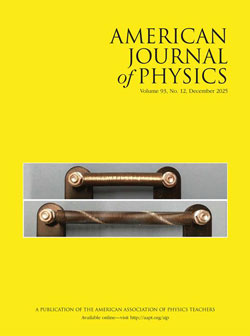 December 2025
December 2025
Volume 93, Issue No. 12
The nonlinearity of helical springs: An energy-based approach
A general expression for the elastic potential energy of a helical spring is derived using the basic concepts of elasticity theory and geometry. Both the translational and the rotational displacement of the spring's moving ends are considered. The resulting expression is employed to derive the general relation between force and spring height, and corrections to Hooke's law are discussed. The results can be used to estimate the magnitude of nonlinear effects in realistic situations, to predict how springs unwind under load, and to determine the spring constant when spring ends are allowed to rotate freely. This energy-based approach is suitable for inclusion in advanced mechanics courses. The results are validated via measurements on steel springs using a simple experimental setup appropriate for use in physics laboratories at all levels.
EDITORIAL
In this issue: December 2025 by John Essick; Harvey Gould; Claire A. Marrache-Kikuchi; Beth Parks; Donald Salisbury; Jan Tobochnik; Keith Zengel. DOI: 10.1119/5.0308238
LETTERS TO THE EDITOR
The acceleration at maximum jerk in fall with quadratic drag by Hasan Yıldırım. DOI: 10.1119/5.0304999
PAPERS
The nonlinearity of helical springs: An energy-based approach by Saša Ilijić; Ana Babić; Dora Ivrlač; Andrew DeBenedictis. DOI: 10.1119/5.0252682
Editor's Note: Did you know that springs can wind themselves up under load? If not, you should delve into this paper, which explains why. It studies the torsion and bending of helical springs using an energy-based approach (instead of the usual force-and-torque analysis) to derive the spring's torque under load and compares the predictions with the real-life behavior of ordinary classroom steel springs. Appropriate for advanced mechanics courses.
Orbital motion of primordial black holes crossing Sun-like stars by Vitorio A. De Lorenci; David I. Kaiser; Patrick Peter. DOI: 10.1119/5.0256145
Editor's Note: Small primordial black holes could conceivably orbit in the interior of our own sun, as well as in other stars in our universe. In those orbits, they could produce detectible gravitational waves and could even account for our missing dark matter. The authors argue that orbital calculations can be undertaken in the context of Newtonian dynamics, making this numerical integration problem a compelling example to include in an introductory or intermediate mechanics course.
Geometric adiabatic angle in anisotropic oscillators by Fumika Suzuki; Nikolai A. Sinitsyn. DOI: 10.1119/5.0270675
Editor's Note: Two features of classical mechanics that require careful attention are action-angle variables and the adiabatic evolution of systems. The authors discuss some of the subtleties and common misconceptions that arise in the teaching of these topics. The effective anisotropic mass oscillator and the Foucault pendulum systems will be of interest to teachers of advanced classical mechanics courses.
Solving free-fall motion in a rotating frame through analogy with the electromagnetic problem by Bin Zhang. DOI: 10.1119/5.0176562
Editor's Note: The analogy between the fall of a mass in a rotating frame and the motion of a charged particle in crossed electric and magnetic fields is developed in a way that allows students in lower-level courses to understand motion in the presence of a Coriolis force.
Approaching the thermodynamic limit of an ideal gas by Prabal Adhikari; Brian C. Tiburzi; Sona Baghiyan. DOI: 10.1119/5.0200913
Editor's Note: This paper considers the effect of interactions with walls on the ideal gas, illustrating the approach to the thermodynamic limit. The paper concludes with a variety of problems at different levels of difficulty that could be assigned in statistical mechanics courses.
Free electron theory for thin metal films by Philip B. Allen. DOI: 10.1119/5.0225186
Editor's Note: Two-dimensional materials present quantum well states perpendicular to their surface, whose energy can be measured using scanning tunneling microscopy (STM) for instance. This paper revisits the standard free electron theory, adapting it to the 2D case, to make sense of experimental STM spectra on aluminum thin films. It could serve as an illustration or an exercise for advanced quantum mechanics classes.
COMPUTATIONAL PHYSICS
Computational modeling of diffusive dynamics in a bouncer system with an irregular surface by Luiz Antonio Barreiro. DOI: 10.1119/5.0295573
Editor's Note: The author simulates a ball bouncing on a sinusoidally varying surface. This system is an example of a classical system that obeys simple deterministic dynamics, which can exhibit behavior that is indistinguishable from random. The results reinforce the fact that classical systems that appear random are actually deterministic.
INSTRUCTIONAL LABORATORIES AND DEMONSTRATIONS
Efficient and affordable thermoelectric measurement setup using Arduino and LabVIEW for education and research by Alex J. Oh; Colby J. Stoddard; Craig Queenan; Seongshik Oh. DOI: 10.1119/5.0289649
Editor's Note: With this paper, the authors describe an inexpensive and reliable method for measuring thermoelectric and resistive properties of materials in an instructional laboratory. Step-by-step instructions are provided for constructing the experimental setup and for carrying out the measurements on both a thin film and type K thermocouple wire sample, along with how the challenges of Arduino's low voltage resolution and forming reliable electrical contacts were overcome. The acquired results are shown to be consistent with published values for the studied materials. This project will be of interest to instructors of advanced laboratory courses as well as those teaching condensed matter and material science courses with a laboratory component.
NOTES AND DISCUSSIONS
Characterizing the breadth of the Planck function by B. Cameron Reed. DOI: 10.1119/5.0281796
Editor's Note: Many instructors will have heard that the peak of the solar spectrum corresponds with the peak sensitivity of human vision, around 500 nm, and most also know that the wavelength peak does not correspond to the frequency peak. But perhaps not so many of us have thought of those two facts together or considered to what extent the Sun's black-body spectrum overlaps with our eye's range of sensitivity. This paper helps instructors think about not just the peak of the spectrum but also its breadth and to consider this breadth as a function of frequency, photon number, or wavelength.

